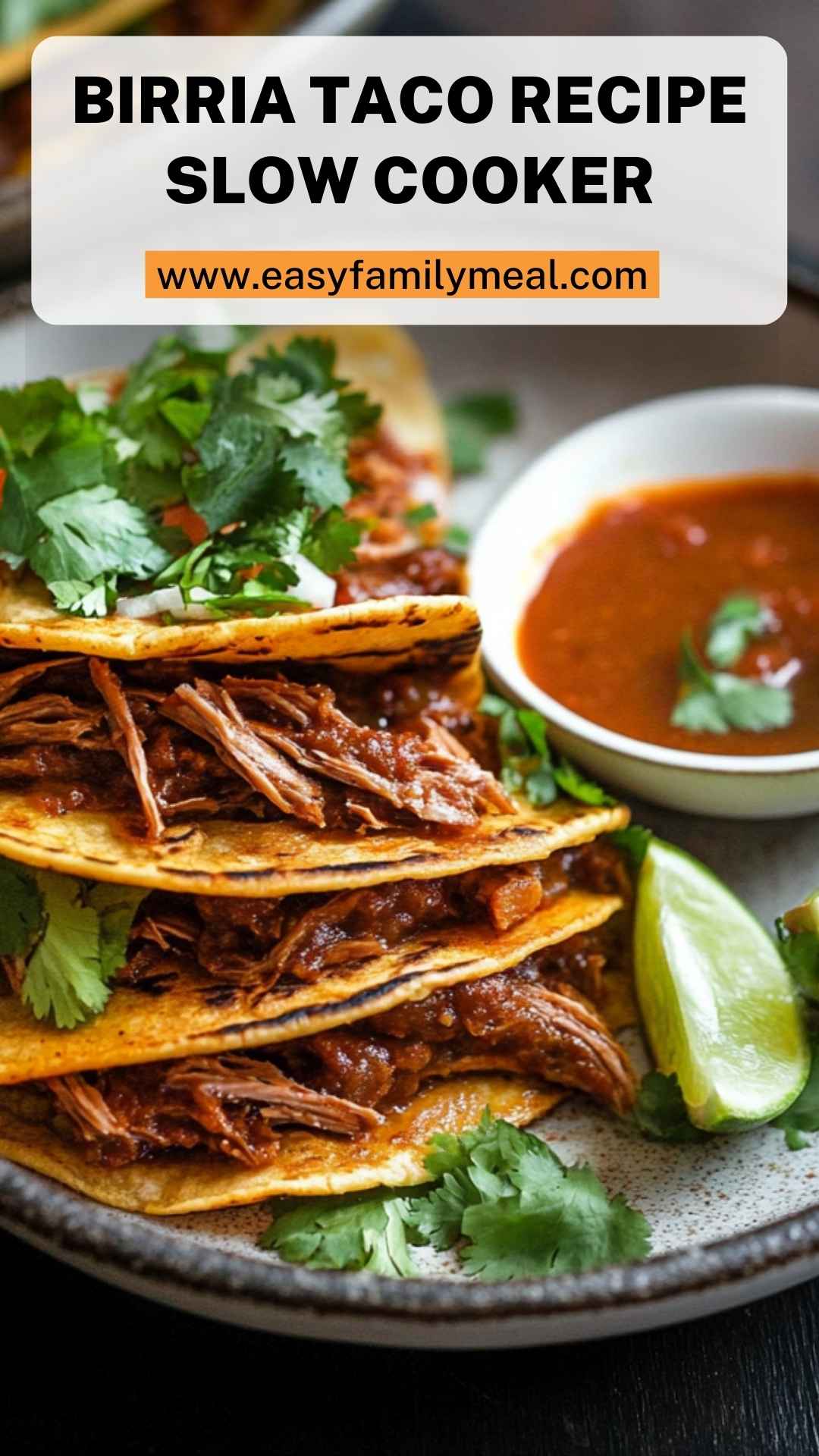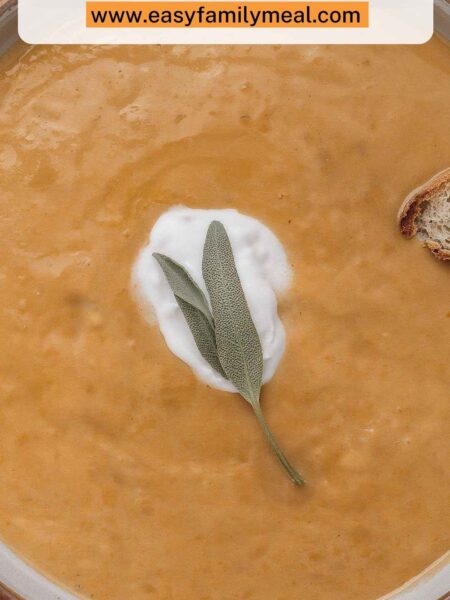Before diving into the delicious world of Singapore curry noodles stir fry, let’s talk about what to pair it with. This dish shines brightly on its own, but a few accompaniments can elevate the meal further. Here are some ideas:
Spring Rolls: Crispy, light, and filled with fresh veggies or shrimp. They complement the noodles with their crunchy texture.
Chili Sauce: For those who love heat, a drizzle of chili sauce can add a nice kick. Sriracha or sambal oelek works wonders.
Cucumber Salad: A chilled cucumber salad brings a refreshing contrast to the rich flavors of curry.
Lemonade or Iced Tea: A cold drink can balance out the spiciness. Lemonade, in particular, offers a tart counterpoint.
Coconut Rice: The creaminess of coconut rice can be a delightful side, pairing excellently with the dish’s spices.
Now, let’s delve into the exploration of Singapore curry noodles stir fry.
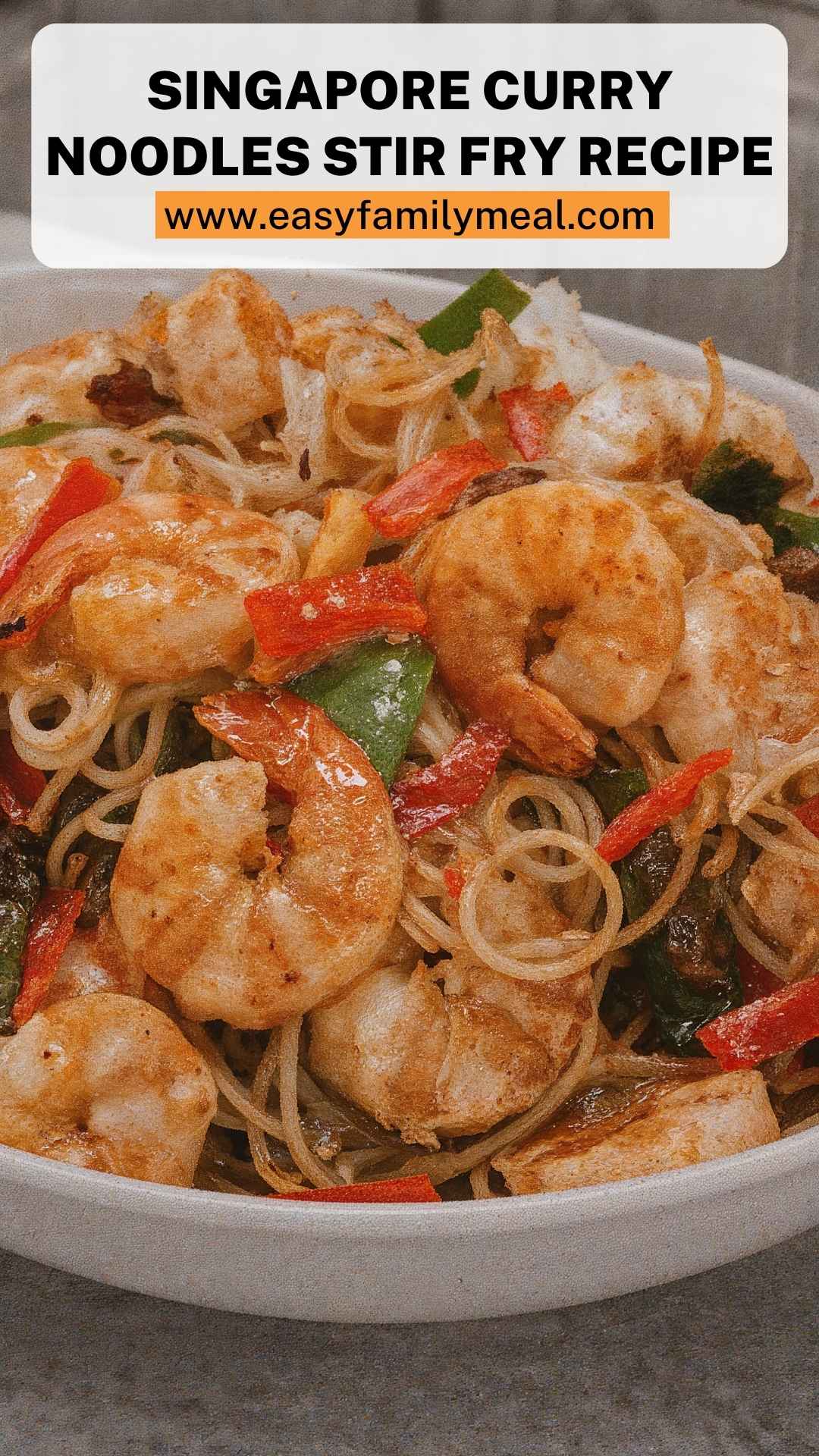
What is Singapore Curry Noodles Stir Fry?
Singapore curry noodles stir fry embodies a fusion of Chinese and Malay culinary traditions. At its core, you’ll find rice vermicelli noodles coated in a beautifully fragrant curry sauce. The dish typically includes shrimp, char siu (Chinese BBQ pork), vegetables, and aromatic spices.
What sets Singapore curry noodles apart from regular curry noodles? It’s the magical marriage of flavors from spices like turmeric, curry powder, and sesame oil, creating a mouthwatering dish that is both flavorful and satisfying.
How Does It Taste Like?
Let’s paint a picture. The first bite unveils a blend of creamy and spicy notes from the curry, followed by the satisfying crunch of fresh vegetables. The shrimp brings a burst of sweetness, while the char siu adds a smoky depth. Each forkful offers a balance of heat, sweetness, and umami. The noodles, perfectly cooked, serve as a tender canvas for the immersive flavors.
If you love food that excites the taste buds and warms the soul, this dish is for you.
Why You’ll Love This
You might be asking why you should dive into making Singapore curry noodles stir fry. Here are a few compelling reasons:
Quick and Easy: In less than 30 minutes, you can have a vibrant and flavorful meal on your table, perfect for busy weeknights.
Customizable: You can tweak ingredients based on what you have at home. Want it extra spicy? Add more chili. Prefer vegetarian? No problem!
Nutrient-Rich: Packed with protein from the shrimp and eggs and loaded with veggies, this dish provides a wholesome meal.
Family-Friendly: Kids often love the colorful presentation and slightly sweet flavor, making it an excellent choice for family dinners.
Impressive: Serve it at parties or gatherings, and it will surely impress guests with its inviting aroma and vibrant colors.
Ingredients
Here’s what you will need for a tasty Singapore curry noodles stir fry:
- 1 tbsp mild yellow curry powder
- ½ tbsp ground turmeric
- 1 tbsp light soy sauce
- 1 tbsp premium fish sauce
- 4 tbsp neutral cooking oil (such as vegetable or peanut oil)
- 1 tsp toasted sesame oil (adds nutty depth)
- ½ tsp white pepper (adds gentle heat)
- 2 large eggs, lightly beaten
- 200 g dried rice vermicelli noodles
- 200 g peeled and deveined shrimp
- 100 g Chinese-style BBQ pork (char siu), sliced thin
- 1 handful thinly sliced red bell pepper
- 1 handful thinly sliced green bell pepper
- 1 handful julienned carrots
- 1 large shallot, finely chopped
- 4 cloves garlic, minced
Gather these ingredients, and let’s get started!
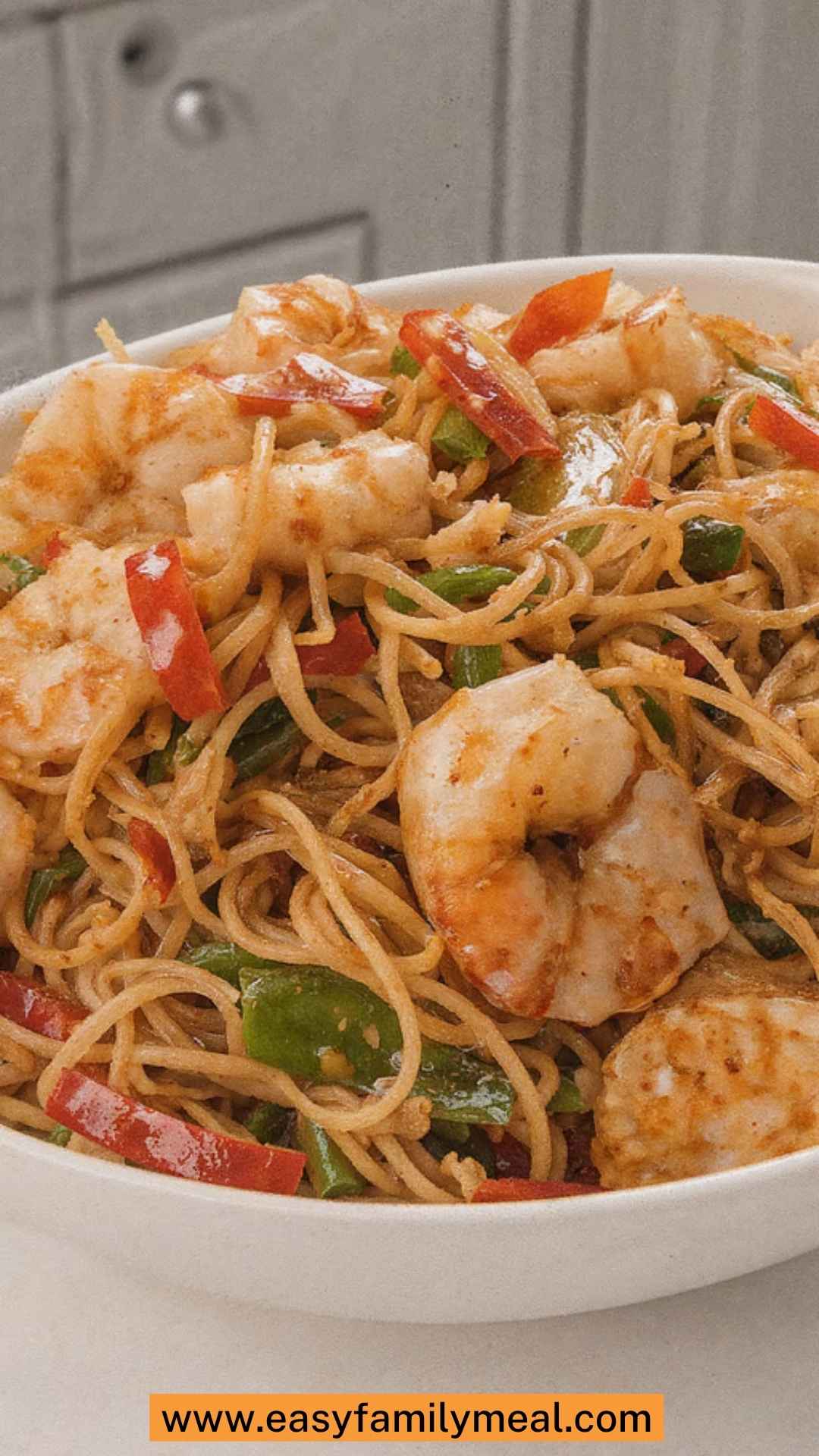
Step by Step Directions
Step 1: Cook the Noodles
Begin by boiling water in a large pot. Once it’s bubbling, add the dried rice vermicelli noodles. Cook them according to the package instructions, usually around 3-5 minutes, until they’re tender but still firm. Drain and rinse under cold water to prevent sticking.
Step 2: Prepare the Sauce
In a bowl, mix together the curry powder, turmeric, soy sauce, fish sauce, and white pepper. This combination will serve as the heart of your dish, so give it a good stir to blend the spices.
Step 3: Sauté the Aromatics
In a large skillet or a wok, heat the neutral cooking oil over medium-high heat. Add the minced garlic and chopped shallots, sautéing until the shallots turn translucent. The aroma should begin to fill your kitchen.
Step 4: Add the Shrimp and Pork
Now, toss in the shrimp and char siu. Cook until the shrimp turn pink and the pork is heated through. This will only take about 3-5 minutes.
Step 5: Vegetables Join the Party
Add the sliced bell peppers and julienned carrots. Stir-fry for another couple of minutes, just until they are slightly tender yet still crisp. The colors should be vibrant and enticing.
Step 6: Create the Curry Base
Pour your prepared sauce over the shrimp and vegetables, tossing everything to ensure an even coating. Let it simmer for a minute so the flavors meld beautifully.
Step 7: Add the Noodles
Now, introduce the drained rice vermicelli noodles to the pan. Using tongs, gently toss everything together until the noodles are evenly distributed amongst the shrimp and vegetables.
Step 8: Finish with Eggs
Push everything to one side of the pan and pour the beaten eggs into the cleared space. Allow the eggs to set slightly before scrambling them into the noodle mixture. This adds a richness to the dish.
Step 9: Drizzle the Sesame Oil
Finally, drizzle the toasted sesame oil over the entire dish. Give it one last toss to distribute the oil and flavors.
Step 10: Serve Hot
Scoop the Singapore curry noodles stir fry onto plates and enjoy immediately. If desired, garnish with some fresh cilantro or lime wedges for that added zest.
Tips On Making Singapore Curry Noodles Stir Fry
Here are five tips that will help you nail this dish and impress anyone who joins your table:
Prep Everything Beforehand: Having all your ingredients chopped and ready to go makes the cooking process smoother and quicker.
Don’t Overcook Your Noodles: Aim for al dente texture. They will continue cooking when mixed with the hot ingredients.
Add More Vegetables: Feel free to toss in any veggies you love or need to use up, like snow peas or bok choy, to sneak in more nutrition.
Experiment with Proteins: If shrimp isn’t your thing, try chicken, tofu, or even beef for a different spin on this classic.
Taste as You Go: Adjust the seasonings based on your preferences. More soy sauce for saltiness or extra fish sauce for depth can customize this dish perfectly.
These values can change based on portion sizes and ingredient modifications.
How Do You Store This Singapore Curry Noodles Stir Fry?
Storing leftovers? It’s simple! Place the stir fry in an airtight container and refrigerate it for up to 3 days. To reheat, simply warm it in a skillet or microwave until heated through. The flavors often improve after a day, making it a perfect make-ahead meal!
What Other Substitutes Can You Use in Singapore Curry Noodles Stir Fry?
Running low on any ingredients? No problem! Here are some substitutes that work:
Squid/Calamari: Replace shrimp for a chewier seafood option. Just make sure to cook them for a shorter time to prevent toughness.
Tofu: A great exchange for protein; use firm tofu for a satisfying bite, adding it in when sautéing vegetables.
Rice or Egg Noodles: If you’re not keen on vermicelli, opt for rice noodles or thin egg noodles for a different texture.
Hoisin Sauce: You can substitute fish sauce with hoisin for a sweeter, less fishy flavor. It will alter the taste nicely, making it unique.
Peppers: Swap out the bell peppers for any vegetable you have on hand, like snap peas or broccoli, to keep things versatile.
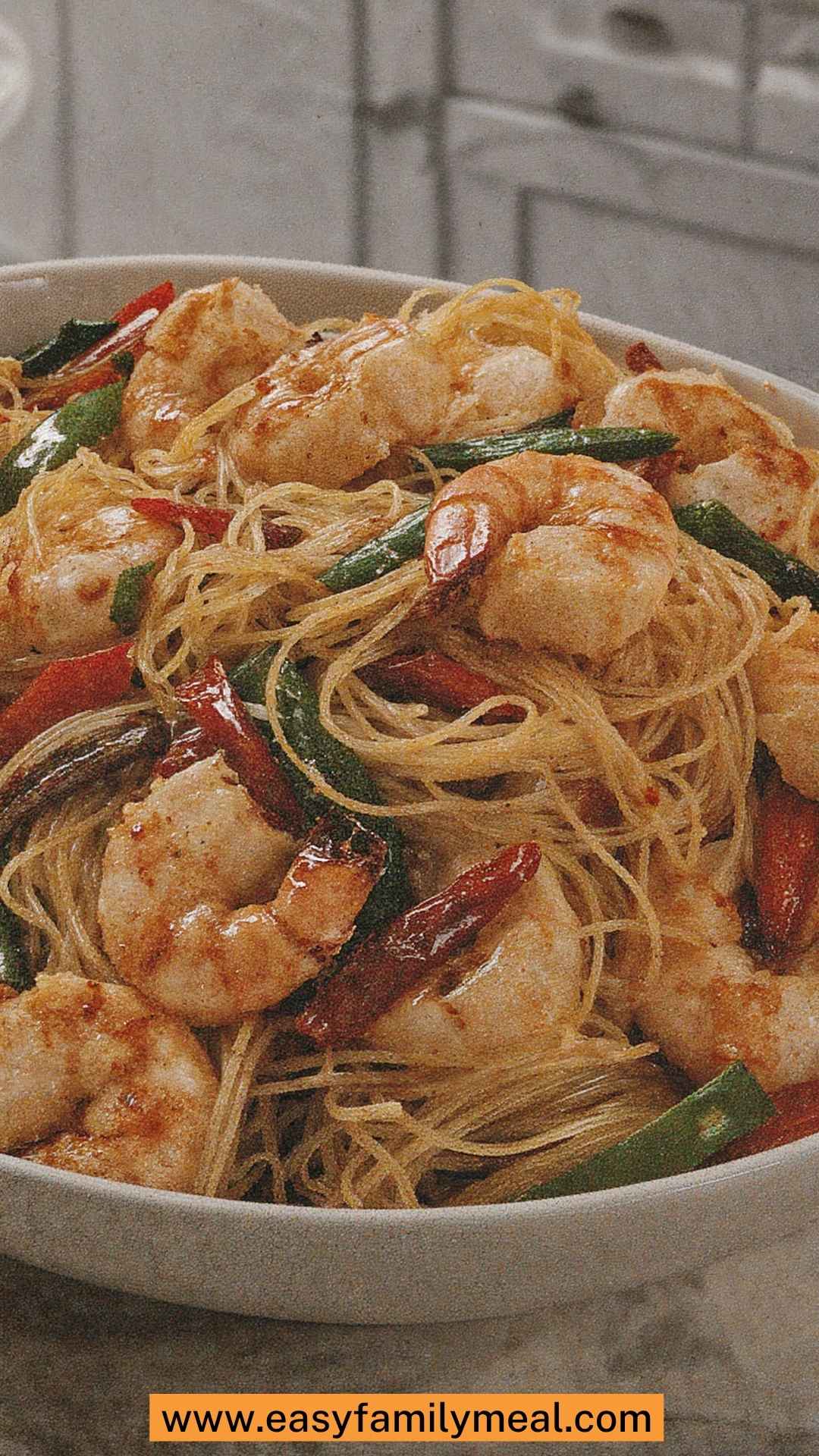
Conclusion
Singapore curry noodles stir fry offers vibrant flavors, quick preparation, and hearty satisfaction—all in one dish. Each bite transports you right to the bustling streets of Singapore, sparking a joy that’s hard to resist. Whether you’re making it for a family dinner or impressing friends, this meal shines.
Get those ingredients together, unleash your inner chef, and enjoy this delightful culinary adventure in your kitchen. If you’re like me, you’ll end up with this dish on repeat. Happy cooking!
You’ll also like the following recipes!
- Shredded Hash Browns Recipe
- Champurrado Mexican Hot Chocolate Corn Drink Recipe
- Food Lab Complete Guide To Sous Vide Steak
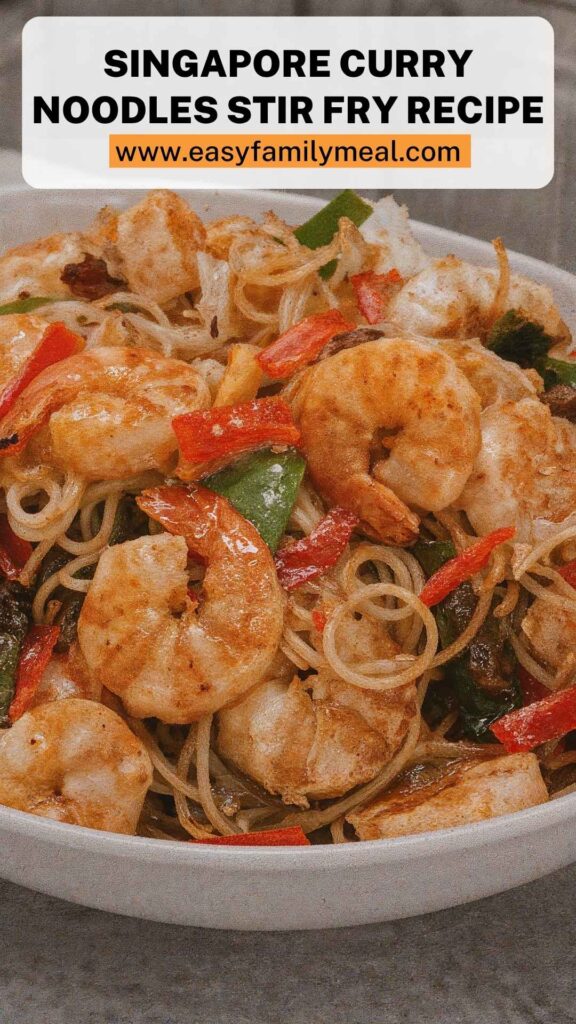
Singapore Curry Noodles Stir Fry Recipe – Easy Family Meal
Description
Imagine this: a bustling street market filled with the aroma of spices wafting through the air. Vendors calling out their specialties, and people savoring the vibrant flavors of Asian cuisine. Singapore curry noodles stir fry evokes that atmosphere right in your kitchen. This dish has a way of transporting you to the heart of Singapore’s culinary scene, all while being simple enough to whip up at home.
I first encountered curry noodles in a little hawker center during my travels. The essence of tasty street food made me realize I could recreate this flavor at home. The beauty of the dish lies in its vibrant colors, a dance of textures, and a harmonious blend of spices that play on the palate.
So, what is this delightful concoction? Let’s explore!
Ingredients
Instructions
Step 1: Cook the Noodles
-
Begin by boiling water in a large pot. Once it's bubbling, add the dried rice vermicelli noodles. Cook them according to the package instructions, usually around 3-5 minutes, until they’re tender but still firm. Drain and rinse under cold water to prevent sticking.
Step 2: Prepare the Sauce
-
In a bowl, mix together the curry powder, turmeric, soy sauce, fish sauce, and white pepper. This combination will serve as the heart of your dish, so give it a good stir to blend the spices.
Step 3: Sauté the Aromatics
-
In a large skillet or a wok, heat the neutral cooking oil over medium-high heat. Add the minced garlic and chopped shallots, sautéing until the shallots turn translucent. The aroma should begin to fill your kitchen.
Step 4: Add the Shrimp and Pork
-
Now, toss in the shrimp and char siu. Cook until the shrimp turn pink and the pork is heated through. This will only take about 3-5 minutes.
Step 5: Vegetables Join the Party
-
Add the sliced bell peppers and julienned carrots. Stir-fry for another couple of minutes, just until they are slightly tender yet still crisp. The colors should be vibrant and enticing.
Step 6: Create the Curry Base
-
Pour your prepared sauce over the shrimp and vegetables, tossing everything to ensure an even coating. Let it simmer for a minute so the flavors meld beautifully.
Step 7: Add the Noodles
-
Now, introduce the drained rice vermicelli noodles to the pan. Using tongs, gently toss everything together until the noodles are evenly distributed amongst the shrimp and vegetables.
Step 8: Finish with Eggs
-
Push everything to one side of the pan and pour the beaten eggs into the cleared space. Allow the eggs to set slightly before scrambling them into the noodle mixture. This adds a richness to the dish.
Step 9: Drizzle the Sesame Oil
-
Finally, drizzle the toasted sesame oil over the entire dish. Give it one last toss to distribute the oil and flavors.
Step 10: Serve Hot
-
Scoop the Singapore curry noodles stir fry onto plates and enjoy immediately. If desired, garnish with some fresh cilantro or lime wedges for that added zest.
Nutrition Facts
Servings 4
- Amount Per Serving
- Calories 327kcal
- % Daily Value *
- Total Fat 19.7g31%
- Saturated Fat 3.7g19%
- Trans Fat 0.1g
- Cholesterol 235mg79%
- Total Carbohydrate 18g6%
- Dietary Fiber 2g8%
- Sugars 2g
- Protein 20g40%
* Percent Daily Values are based on a 2,000 calorie diet. Your daily value may be higher or lower depending on your calorie needs.
Note
- Prep Everything Beforehand: Having all your ingredients chopped and ready to go makes the cooking process smoother and quicker.
- Don’t Overcook Your Noodles: Aim for al dente texture. They will continue cooking when mixed with the hot ingredients.
- Add More Vegetables: Feel free to toss in any veggies you love or need to use up, like snow peas or bok choy, to sneak in more nutrition.
- Experiment with Proteins: If shrimp isn’t your thing, try chicken, tofu, or even beef for a different spin on this classic.
- Taste as You Go: Adjust the seasonings based on your preferences. More soy sauce for saltiness or extra fish sauce for depth can customize this dish perfectly.




